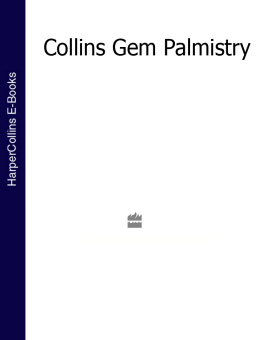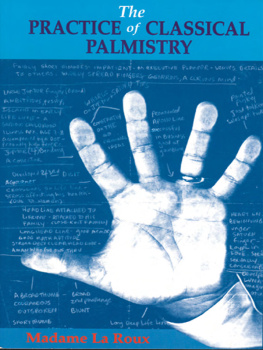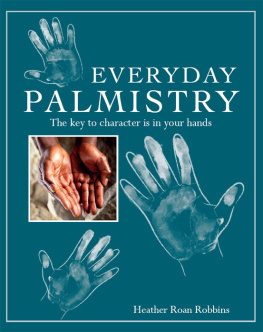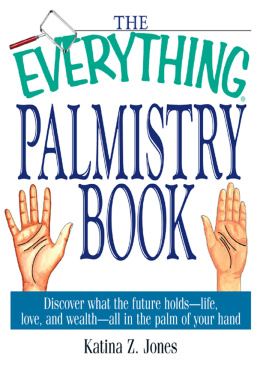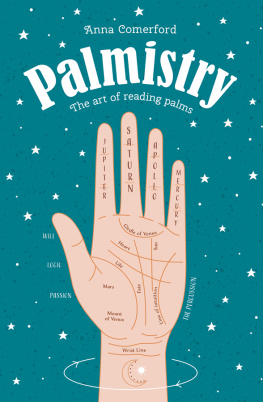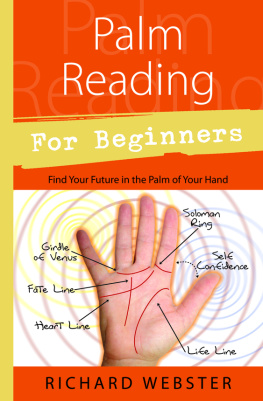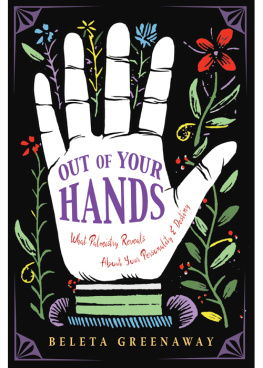THE LAWS OF SCIENTIFIC HAND READING
A Practical Treatise on the Art Commonly Called Palmistry
WILLIAM GEORGE BENHAM

This 2012 edition published by Barnes & Noble, Inc.
All rights reserved. No part of this publication may be reproduced, stored in a retrieval system, or transmitted, in any form or by any means, electronic, mechanical, photocopying, recording, or otherwise, without prior written permission from the publisher.
Barnes & Noble, Inc.
122 Fifth Avenue
New York, NY 10011
ISBN: 978-1-4114-6532-9
INTRODUCTION
THERE has never been conceived or made by man any instrument, machine, or contrivance, capable of such a diversity of usefulness as the human hand. Nothing has ever existed with such infinite adaptability to various needs, or capable of being trained to such degrees of dexterity and versatility. Nor is it likely that as perfect a machine will ever be produced by human skill, for the only thing the human hand cannot do is to create an instrument as perfect as itself. There is no possible question but that the fineness or coarseness of a human hand indicates whether it can better do fine or coarse work, nor is there a doubt but that other markings on it show for what lines of work it is best adapted. The delicate hand of a lady cannot perform the same hard labor as the large, strong hand of a blacksmith, nor can the blacksmith do the fine embroidery so deftly wrought by the lady's hand. Neither has the blacksmith's brain the little embroideries of the mind. His brain is of heavier construction, hers more delicately built. His hand, like his brain, is heavy: her hand is fine like her brain. Never was there a hand that did not exactly reflect the brain that directs it, and this is the basis from which a scientific study of the hand must begin. To get at the secrets of the mind embodies the effort toward which scientific hand-reading aspires, for mind is the guiding force in life. Upon that hypothesis are based the teachings of this book.
PERSONALITIES
My special interest in the hand began at thirteen years of age, when by chance I fell in with an old gypsy who taught me what she knew of Gypsy chiromancy. This was not much, it is true, but enough to give direction to my thoughts. Hampered by the entire absence of any literature on the subject, my first efforts were very laborious. In the beginning it was necessary to take a mere tradition and apply it to hundreds of hands, noting the result. This was the first system adopted. Thus the investigation of a single indication often consumed a year, and in the end might be found unreliable and have to be thrown away. No help was found from professionals, for nearly all proved to be ignorant, unlettered, and trying solely to gain money, without any effort in the direction of scientific investigation. During most of this time the word Palmistry was so buried under a mass of public disapproval, that a self-respecting person dared not say that he was even interested in it. Fully persuaded that it had a scientific foundation, I set about to discover it. All my investigations led more and more to the belief that it was a subject well worthy of deep study, in search of the key, as yet undiscovered.
I soon found that Physiology played a most prominent part, and then that health as affecting temperament and character, was a leading factor. In order to prepare myself for a proper consideration of these matters, I studied medicine, so that I might be familiar with the entire anatomical construction of the body, and having gained entree to several hospitals, the State institutions for the imbecile, insane, blind, and deaf, the almshouse, jails, and a penitentiary, I used the inmates of these institutions as object lessons, by which means I gained much valuable information on health indications, criminology, and character. I secured all of the available literature on the subject, but it was of a fragmentary nature, only a small portion of it being reliable. I consulted palmists of every nationality, and learned what I could from them, which was practically nothing, for most professionals had frankly acknowledged to me that they knew very little about the hand, but relied entirely upon their natural shrewdness. I then began the study of separate classes and professions of men and women, taking the leaders of each class and studying them. Thus I examined the most prominent doctors, lawyers, ministers, speakers, actors, singers, musicians, literary people, hypnotists, spiritualists, murderers, forgers, and so on through the scale of human life. This investigation bore much fruit, and, combined with my previous work, gave me the foundation and confirmations from which I have built up the structure which this book contains.
That there is so much information in the hand will be a surprise to many, and when it is seen how logical, rational, and even commonplace, hand-reading is, perhaps it will then be taken out of the occult class to which it distinctly does not belong, and placed among the other rational means at the service of mankind, whereby they may be enabled to gain a better knowledge of themselves. In the preparation of this book, my ambition has been so to present this matter to the public, that they would see it from a novel point of view, and by disclosing the logical basis on which it rests, presented without a vestige of mysticism or occult halo, lift it from its position as an effete superstition, and place it among the modern sciences. My ambition has been to make Palmistry not an amusement, nor a centre around which cranks might congregate, but a study worthy of the best efforts of the best minds.
When we can tell our sons and daughters what sphere in life they are best fitted to occupy, and what studies they can best master, we shall have largely reduced the failures of young men and women. When we can prevent the marriage of people whose temperaments make it absolutely impossible that they should live together harmoniously, then we shall have largely decreased the number of divorces and wrecked lives. To do these things manifestly requires that we should have a correct estimate of the person with whom we are dealing. In the following pages the manner in which this may be done is outlined and explained. If this book, which is the essence of my labors, should bear the fruit I have desired and believed it would, if the intelligence of the reading public can find in these pages a crystallization of such facts as shall lead them to thoroughly investigate, I shall be satisfied to abide by the results, fearing not the issue.
ILLUSTRIOUS ILLUSTRATORS
The illustrations in the following pages are made from the hands of people located in all parts of the United States. The collection comprises hands of the most famous men and women of the agethose who have made history and ruled nations. The leaders of every profession and walk in life, politics, war, business, art, society, letters, or crime, are gathered here. As the subjects from whose hands these photographs, prints, or casts were taken, live in every part of this country, it has been the work of many years to collect them. Their value lies in the fact that they represent typical lives of typical people, with typical hands. Several reasons make it unwise to give names of the persons from whose hands illustrations have been secured, even though their well-known qualities would make the illustrations more convincing. In the first place, the largest number could not have been obtained except upon the pledge that no undue prominence would be given the original. Second, some hands illustrate markings which indicate undesirable qualities, with which it would not be wise or proper to identify living subjects.


